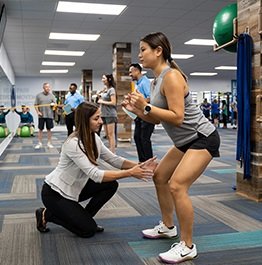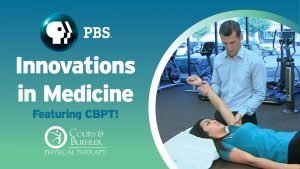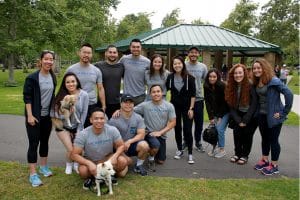
I Tore My ACL… Now What?
August 16, 2017I’ve played soccer since I was five years old. As I began to play at a more competitive level, I started to hear more and more about the “dreaded” ACL tear. During my first year playing in college, we had four women on my team tear their ACL.
I didn’t know much about their injuries, except that they would be out of the sport for a long time. And hopefully, if the surgery and rehab went well, they would be back to playing the next year. With the growing number of athletes beginning to specialize at a younger age, it is certain that more athletes are at risk for ACL tears.
What is the ACL and how does it get injured?
 ACL, is the anterior cruciate ligament. The ACL is one of four the major ligaments of the knee. The ACL connects the thigh bone (femur) to the shin bone (tibia). Its job is to resist the two bones from separating and twisting.
ACL, is the anterior cruciate ligament. The ACL is one of four the major ligaments of the knee. The ACL connects the thigh bone (femur) to the shin bone (tibia). Its job is to resist the two bones from separating and twisting.
ACL injuries are common in athletes especially those in pivoting sports such as soccer, basketball, football and hockey. About 70% of ACL injuries are non-contact. Most non-contact injuries occur when the foot is planted and the knee twists. Women are at an increased risk for ACL tears due various intrinsic and extrinsic factors.
What does it feel like?
When you tear your ACL you may hear a loud *pop*. Swelling is usually instant (within hours of injury). Some people are unable to walk on the injured leg and may feel that the leg gives way.
How is it Diagnosed?
 If you are seen by a physical therapist, he or she may perform a series of hands-on tests to determine the likelihood of an ACL tear, as well as thoroughly document how the knee was injured. They may also examine other structures in the knee for possible involvement. An orthopedic surgeon will likely perform an MRI to confirm the diagnosis of an ACL tear and see any other structures involved.
If you are seen by a physical therapist, he or she may perform a series of hands-on tests to determine the likelihood of an ACL tear, as well as thoroughly document how the knee was injured. They may also examine other structures in the knee for possible involvement. An orthopedic surgeon will likely perform an MRI to confirm the diagnosis of an ACL tear and see any other structures involved.
I tore my ACL, what’s next?
Most people who tear their ACL have surgery to repair the tear. Some people can choose to forego surgery by modifying their activity level, while there is also a select group of people who return to competition without having surgery.
If you and your orthopedic surgeon decide surgery is the next step, you may being working with your physical therapist before surgery (“Pre-hab”) to restore range of motion, help decrease the swelling, and strengthen your thigh muscles (quadriceps).
How long is the Recovery?
 After surgery, most people will usually be on crutches to limit weight-bearing on the injured leg, and a brace that limits the motion in your knee to protect the repaired ligament. Following your surgeons guidelines, your therapist will design an individualized program to gradually improve your knee range of motion and strength. Timelines may vary based on the type of graft used during surgery, surgeon guidelines, and pre-operative status.
After surgery, most people will usually be on crutches to limit weight-bearing on the injured leg, and a brace that limits the motion in your knee to protect the repaired ligament. Following your surgeons guidelines, your therapist will design an individualized program to gradually improve your knee range of motion and strength. Timelines may vary based on the type of graft used during surgery, surgeon guidelines, and pre-operative status.
Most people who undergo ACL repair are in for a lengthy rehabilitation with large emphases on:
- Regaining quadriceps strength
- Balance/proprioception
- Landing mechanics
- Sport-specific exercises to prevent re-injury.
Bracing and crutches will continue approximately for four weeks. Returning to running is usually initiated between 10-12 weeks. Patients who wish to return to competition can expect rehabilitation for about 6-9 months. Progression to the next step will be determined by your physical therapist.
Prevention
 More and more coaches are being taught specific drills and warm-ups to help prevent the risk of an ACL tear. It is important to have good strength and proper mechanics to decrease unwanted stresses at the knee. Physical therapists are highly trained individuals that can help you identify weaknesses and help re-train proper running, cutting, jumping and landing mechanics to help you decrease your risk for a future ACL tear.
More and more coaches are being taught specific drills and warm-ups to help prevent the risk of an ACL tear. It is important to have good strength and proper mechanics to decrease unwanted stresses at the knee. Physical therapists are highly trained individuals that can help you identify weaknesses and help re-train proper running, cutting, jumping and landing mechanics to help you decrease your risk for a future ACL tear.
What’s the next step?
If you think you may have torn or sprained your ACL, see your physician or physical therapist right away. The sooner the injury is diagnosed, the quicker the recovery process can begin.
REQUEST A FREE CONSULTATION
We will contact you to confirm your appointment.WANT MORE TIPS?
Faith enjoys anything with sunshine, good food and sports. She enjoys traveling with her husband, and getting together with family and friends.
Latest posts by Faith Rea, PT, DPT (see all)
- I Tore My ACL… Now What? - August 16, 2017
- Healthy Eats: Summertime Salmon Patties - June 05, 2017
- Exercise Is Brain Food - May 18, 2017
- 5 Reasons to Switch Out the High Heels - May 09, 2017
Reader Interactions
Leave a comment Cancel reply
You must be logged in to post a comment.
SIGN UP FOR
LIFE+ is a FREE membership
that offers:
• Informative Newsletters
• Health & Wellness Tips
• Videos from Our Experts
• Special offers
…and much more!
SEARCH

GET MORE TIPS! PAIN 101 TUTORIALS
EXPLORELATEST TWEETS
ARCHIVES
- February 2025
- August 2024
- February 2024
- November 2023
- September 2023
- July 2023
- June 2023
- January 2023
- November 2022
- October 2022
- September 2022
- August 2022
- July 2022
- June 2022
- May 2022
- April 2022
- March 2022
- December 2021
- November 2021
- October 2021
- September 2021
- August 2021
- July 2021
- June 2021
- April 2021
- March 2021
- February 2021
- January 2021
- December 2020
- November 2020
- October 2020
- September 2020
- August 2020
- April 2020
- March 2020
- February 2020
- January 2020
- December 2019
- November 2019
- October 2019
- September 2019
- August 2019
- July 2019
- June 2019
- May 2019
- April 2019
- March 2019
- February 2019
- January 2019
- November 2018
- September 2018
- August 2018
- July 2018
- June 2018
- May 2018
- April 2018
- March 2018
- February 2018
- January 2018
- December 2017
- November 2017
- October 2017
- September 2017
- August 2017
- July 2017
- June 2017
- May 2017
- April 2017
- March 2017
- February 2017
- January 2017
- December 2016
- November 2016
- October 2016
- September 2016
- August 2016
- July 2016
- June 2016
- May 2016
- April 2016
- March 2016
- February 2016
- January 2016
- December 2015
- November 2015
- October 2015
- September 2015
- August 2015
- July 2015
- June 2015
- May 2015
- April 2015
- March 2015
- February 2015
- January 2015
- December 2014
- November 2014
- October 2014
- September 2014





